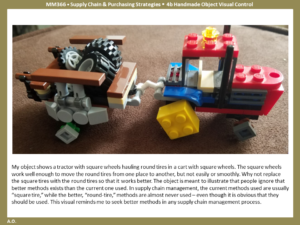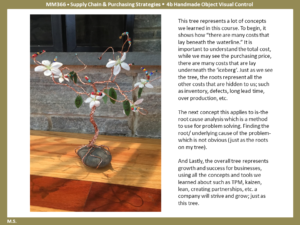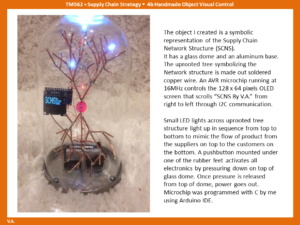In a previous blog post, “Final Exams, Final Mistake,” I described how students in my courses make two types of visual controls to help them remember and apply what they learned.
One visual control is in the form of an 8.5×11 inch sign that reflects the 10-20 most important things they learned in the course (called the “4a” visual control), while the second is a small handmade physical object that represents the key one or two things that they learned in the course (called the “4b” visual control).
In this blog post, I’d like to share with you some wonderful examples of 4b visual controls made by my students in three different courses – one undergraduate and two graduate courses this semester. But first, let me share with you the feedback I received from students about this unique assignment:
- It forces you to think differently
- You have to reflect on the entire course, from the end to the beginning and back to the end
- It helps you understand the concepts better
- It’s good to build a model of what you intend to do, or the result that you seek
- It’s more personalized learning
- The 4b assignment mattered the most to me
- Helps you focus on what you want to remember
- Making something by hand makes you think like a kid again; discovery and learning
- It was fun to make
- It makes you think more deeply
- It promotes creativity
- It’s fun to see the variety of things that everyone else in class makes
- It helps spread the message of the course to other people
- A useful keepsake
- Helps you to always keep the course in mind
- It is an open-ended assignment, unconstrained by the professor’s requirements, so we have freedom to think and create
- More personalized learning
The last bullet point, personalized learning, has been an objective of mine for many years, but especially the last few years (inspired by sensei Chihiro Nakao, see “Evolution in Lean Teaching“).
The success of the 4b visual control reflects the fact that, fundamentally, people like to make things with their hands. And, the conversion of book knowledge in one’s brain into a physical object made by using one’s hands adds a wonderful new dimension to learning.
Four examples of my students 4b visual controls from the Spring 2017 semester are shown below. The written explanations are nice, but it’s even better to hear students in-person explaining what they created, how they created it, and what it means to them when they present it to class. I really look forward to that at the end of the semester. It’s a lot of fun.
The first two are from undergraduate students, the third and fourth are from graduate students (click on images to enlarge):




